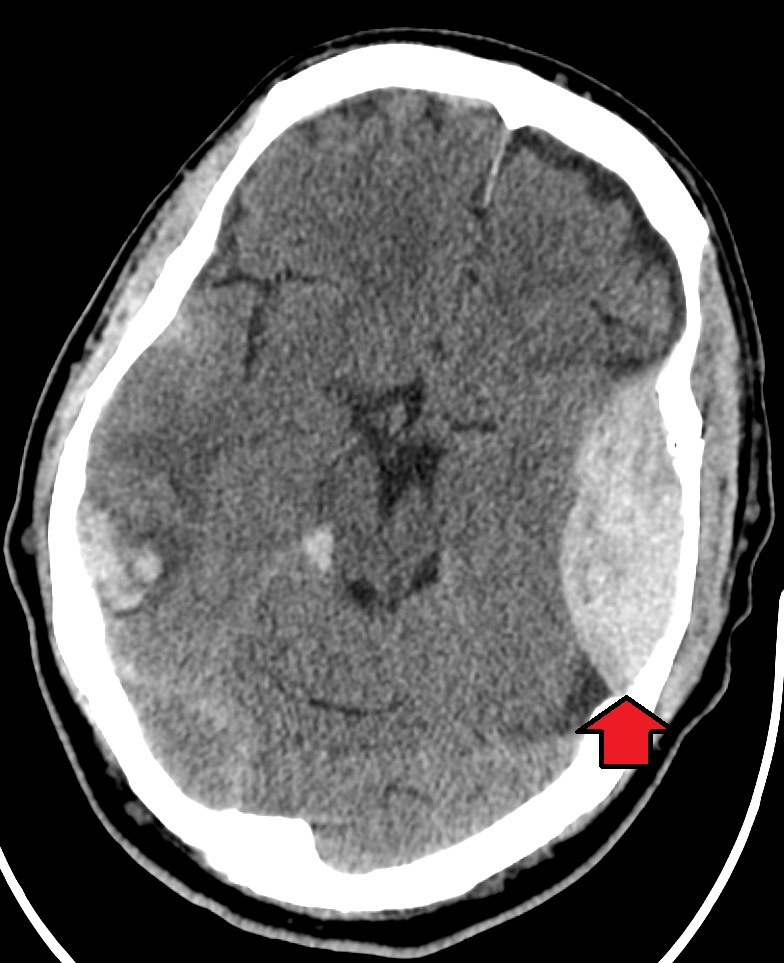Playlist
Show Playlist
Hide Playlist
Epidural Hematoma: Management
-
Slides Head Trauma Epidural Hemorrhage.pdf
-
Download Lecture Overview
00:01 In terms of management, we think about 6 steps. 00:04 And I want you to remember these 6 steps for evaluating and managing these patients. 00:08 The first is the patient should be evaluated and stabilized using standard ACLs protocols. 00:13 How's their airway? What's their breathing? How's circulation? We need to look at those critical factors in evaluating these patients. 00:20 Life threatening injuries should be addressed quickly. 00:24 Efforts should be undertaken to achieve and maintain hemodynamic stability. 00:30 We want to reverse anticoagulation and maintain a normal coagulation avoid coagulopathy. 00:37 Non-contrast head CT should be performed as soon as possible. 00:41 And in selected emergent cases or severe cases emergent neurosurgical consultation is required. 00:47 Surgical clinical decision making is important to determining whether surgery an evacuation of the blood would be helpful early or whether the patient should be monitored. 00:56 Placement of ICP monitoring devices is important when we suspect increases in ICP to follow that intracranial pressure. 01:03 Patients whose ICP can be lowered and maintained, can be managed expectantly and conservatively and those with continued elevations and ICP require often surgical intervention to correct that problem, again to reduce biochemical stress on a traumatic brain. 01:21 How about non-operative management? When do we focus on non-operative management for epidural hematoma? Well, this may be appropriate in certain clinical settings, particularly when the GCS is greater than 8, when there's a small hematoma, when there's an absence of brain herniation signs using our clinical exam or based on radiographic evaluation. 01:42 When the physical exam findings of ICP are absent, so when we're not seeing findings that are suggested have increased ICP, and we can look for papilledema and anisocoria or look at imaging. 01:55 And when we do have an ICP monitoring device in place, an ICP is normal, which would be less than 25 or perhaps 30. 02:06 When we're thinking about non-operative management, these patients are typically maintained initially in the ICU. 02:12 For patients that were we have a suspicion for increased ICP, continuous ICP monitoring can be important. 02:19 And serial head CTS is needed to evaluate the status of the epidural hematoma to ensure that it's not expanding. 02:26 Typically, we perform imaging every 6-8 hours initially, and then ultimately every 12-24 hours to follow the size of the epidural blood. 02:36 Hematoma may undergo gradual reabsorption, but that typically takes weeks, six, eight, sometimes even many more weeks than that. 02:43 And patients did not remain in the hospital while awaiting reabsorption of blood. 02:49 Selected patients may need operative management, particularly those that are clinically unstable with a GCS of less than nine large hematomas clot thickness 15 millimeters high risked for brain herniation based on clinical findings or imaging. 03:06 When physical examinations suggest refractory increases in ICP pupillary palsies, sixth nerve palsies, bilateral sixth nerve palsies, papilledema, those would be findings concerning on exam for increased ICP and particularly when ICP remains elevated on neuro monitoring. 03:23 Persistent epidural hematomas that do not resorb spontaneously may also need to be subsequently evacuated. 03:32 And so in terms of operative management, we may consider conducting or consider a craniotomy with hematoma evacuation to remove the blood. 03:40 Sometimes a burr hole can be placed to evacuate blood through a less invasive procedure. 03:47 And then decompressive craniectomy or craniotomy to remove a bone flap and allow the brain to swell in particularly severe traumatic brain injuries where there's both an underlying traumatic brain injury and an epidural hematoma may be needed to manage cerebral edema.
About the Lecture
The lecture Epidural Hematoma: Management by Roy Strowd, MD is from the course Head Trauma.
Included Quiz Questions
What is the first and most important step in the management of patients with suspected epidural hematoma?
- Evaluation of the patient using ATLS/ACLS protocols
- Reversal of anticoagulation
- Obtaining neuroimaging
- Neurosurgical consultation
- IV mannitol administration
When is operative management indicated for a patient with epidural hematoma?
- Midline shift on CT > 5 mm
- ICP > 10 mm Hg
- Clot thickness > 10 mm
- EDH volume > 20 mL
- GCS score of 11
How often should serial CT scans be obtained within the acute phase of an epidural hematoma, if being managed nonoperatively?
- Every 6–8 hours for 36 hours
- Every 2 hours for 12 hours
- Every day for 1 week
- Every 3–4 hours for 24 hours
- Serial CT scans not indicated for patients undergoing nonoperative management
Customer reviews
5,0 of 5 stars
| 5 Stars |
|
5 |
| 4 Stars |
|
0 |
| 3 Stars |
|
0 |
| 2 Stars |
|
0 |
| 1 Star |
|
0 |




